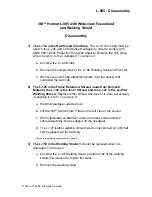
WARNING
Do not install fasteners with a
strength classification lower than
what was originally installed by the
manufacturer. Doing so may cause
equipment failure and/or damage.
Torque Specifications
The components of the motorcycle may be sub-
jected to uneven stresses if the fasteners of the vari-
ous subassemblies are not installed and tightened
correctly. Fasteners that are improperly installed or
that work loose can cause extensive damage. Use an
accurate torque wrench when tightening fasteners,
and tighten each fastener to its specified torque.
Torque specifications for specific components
appear in the procedures and at the end of the appro-
priate chapters. Specifications for torque are pro-
vided in Newton-meters (N•m), foot-pounds
(ft.-lb.) and inch-pounds (in.-lb.). Refer to
Table 7
for torque conversion factors and to
Table 6
for
general torque specifications. To use the general
torque table, first determine the size of the fastener
as described in
Threaded Fasteners
in this section.
Locate that size fastener in
Table 6
, and tighten the
fastener to the indicated torque. Torque wrenches
are described under
Basic Tools
in this chapter.
Self-Locking Fasteners
Several types of bolts, screws and nuts use vari-
ous means to create interference between the
threads of two fasteners to prevent the fasteners
from loosening. The most common types are the ny-
lon-insert nut or a dry adhesive coating on the
threads of a bolt.
Self-locking fasteners improve resistance to vi-
bration and therefore provide greater holding
strength than standard fasteners. Most self-locking
fasteners cannot be reused. The materials used to
form the lock become distorted after the initial in-
stallation and removal. Always discard and replace
self-locking fasteners after their removal. Do not re-
place self-locking fasteners with standard fasteners.
Washers
There are two basic types of washers: flat wash-
ers and lockwashers. Flat washers are simple discs
with a hole for a screw or bolt. Flat washers help
distribute fastener load, they protect components
from fastener damage, and they can be used as spac-
ers and seals. Lockwashers are used to prevent a
fastener from working loose.
When replacing washers, make sure the replace-
ments are of the same design and quality as the orig-
inals.
Cotter Pins
A cotter pin is a split metal pin inserted into a hole
or slot to prevent a fastener from working loose. In
certain applications, such as the rear axle on an ATV
or motorcycle, a cotter pin and castellated (slotted)
nut is used.
GENERAL INFORMATION
5
1
5
U.S. Standard
Metric
60
°
60
°
6
Grade marking
-9.8
T
L
D





































